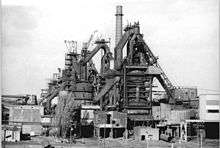EKO Stahl
Coordinates: 52°09′50″N 14°38′22″E / 52.163948°N 14.639340°E
Formerly called |
Eisenhüttenkombinat J.W. Stalin (1950) Eisenhüttenkombinat Ost (EKO) (1961) EKO Stahl Gmbh, (1990) |
|---|---|
| Industry | Steel |
| Website | www.arcelormittal-ehst.com |
EKO Stahl is a steelworks in Eisenhüttenstadt, Brandenburg, Germany. The works was established in the early 1950s on a greenfield site as Eisenhuttenkombinat 'J.W. Stalin', initially only producing pig iron; after 1961 known as Eisenhüttenkombinat Ost (EKO).
Cold rolling facilities were added in 1974, and oxygen steelmaking added in 1984. In 1990 after privatisation during German reunification the company was acquired by Cockerill-Sambre (Belgium) - hot rolling facilities were added in the next decade.
The works became part of Usinor (1990), Arcelor (2001) and ArcelorMittal (2006) through mergers of the holding company. As of 2016 the works is known as ArcelorMittal Eisenhüttenstadt.
History

In 1950 at the third party conference of the Socialist Unity Party of Germany the construction of a new steelworks was announced. A flat, agriculturally unimportant site near Furstenberg was chosen, and 18 Aug 1850 minister Fritz Selbmann symbollically felled a mountain pine tree, indicating the start of the work on construction of the new plant, named Eisenhuttenkombinat 'J.W. Stalin'.[1] Part of the rational for the plant was to compensate for an embargo on steel from western Germany, where most of primary production had historically been located - raw materials (iron ore and coal) were to be supplied from Ukraine and Upper Silesia respectively. And additional rational was to provide work for a large number of German refugees. (see also Flight and expulsion of Germans from Poland during and after World War II.)[2]
In 1953 the number of planned blast furnaces was scaled back from eight to six, and overall plans for the site were reduced to include only production of pig iron.[3] As part of a continued political process of De-Stalinization the plant was renamed Eisenhüttenkombinat Ost (EKO), at the same time the nearby town of Stalinstadt was renamed Eisenhüttenstadt.[4]
In 1968 a cold rolling mill became operational after 3 years of construction; plans for addition of steel production and hot rolling were initiated in the same period, but cancelled in 1967.[5] In 1969 the works was combined with several other steel producing works including those in VVB Stahl- und Walzwerke Berlin and VVB Eisenerz/Roheisen Saalfeld into Bandstahlkombinat Eisenhüttenstadt (BKE).[6]
In 1974 the cold rolling plant was improved to included the production of galvanised and other coated steels.[7] In 1984 a turnkey oxygen conversion (Linz-Donawitz process) based steelworks was installed by Austrian supplier Voest-Alpine.[8]

At German reunification in 1990 EKO became a corporation (EKO Stahl GmbH) - subsequent loss of business in East Germant and eastern Europe caused serious economic problems for the company, as did the high employment rates, and relatively low value product range.[9] During the transition to a free market model employment was reduced from over 12,000 to under 3,000.[10] In 1994/5 Cockerill-Sambre acquired a 60% stake in the company, with the state (via the treuhandanstalt) retaining 40%. As part of the acquisition improvements to the plant were scheduled for completion 1998 including a new blast furnace, a hot rolling mill, and an upgrade to the cold rolling mill.[11] 900 million Deutschmarks in state aid for the reconstruction was approved by the European Union.[12] By 1997 the modernisation work and construction of blast furnace and hot rolling plant had been completed.[13] In 1998 Cockerill-Sambre acquired the remaining 40% of the company for 40 million Deutschmarks.[14] Cockerill-Sambre became part of Usinor in 1998.[15]
A second galvanizing line was added 1999, serving the automotive industry.[16] The company became part of Arcelor in 2001 through the merger of Usinor, Aceralia and Arbed.[17] In 2006 the works became part of ArcelorMittal though the takeover of the parent company.[18]
A third galvanising line was approved in 2007, and construction started in 2008, due to the global recession (see Great Recession) work on the line was halted in 2009, and a blast furnace idled. Economic uncertainty continued to the early 2010s.[19]
References
- ↑ Seidel 1995, p. 45.
- ↑ DDR-Politiker und Manager Karl Döring - "Das Stahlwerk Eisenhüttenstadt ist ein Kind des Kalten Krieges" (in German), 18 Aug 2015
- ↑ Unternehmen Geschichte, p. 4.
- ↑ Unternehmen Geschichte, p. 5.
- ↑ Unternehmen Geschichte, p. 6.
- ↑ Unternehmen Geschichte, p. 7.
- ↑ Unternehmen Geschichte, p. 8.
- ↑ Unternehmen Geschichte, p. 9.
- ↑ Unternehmen Geschichte, p. 10.
- ↑ EurWORK 2009.
- ↑ The Mineral Industry of Belgium and Luxembourg (PDF), U.S. Geological Survey, 1994, pp. 86–7
- ↑ "State aid measures No C 35/94 (previously No NN 397/94), No N 572/94 and No N 728/94 - EKO Stahl GmbH, Eisenhüttenstadt, Brandenburg", europa.eu, 21 Dec 1994
- ↑ Unternehmen Geschichte, p. 12.
- ↑ "Cockerill-Sambre prend le contrôle à 100 % d'Eko Stahl", www.lesechos.fr (in French), 23 Dec 1998
- ↑ See Usinor, Cockerill-Sambre
- ↑ Unternehmen Geschichte, p. 14.
- ↑ Unternehmen Geschichte, p. 16.
- ↑ Unternehmen Geschichte, p. 21.
- ↑ Unternehmen Geschichte, pp. 22-27.
Sources
- "Unternehmen Geschichte", www.arcelormittal-ehst.com (in German), retrieved Apr 2016 Check date values in:
|access-date=(help) - Seidel, Andreas (Jan 1995), Eisenhüttenstadt - Erste Sozialistische Stadt Deutschlands (in German)
- "ArcelorMittal Eisenhüttenstadt, Germany: Business creation and entrepreneurship", EurWORK European Observatory of Working Life, 28 Oct 2009
External links
| Wikimedia Commons has media related to ArcelorMittal Eisenhüttenstadt. |
- Niggemeier, Uwe, EKO STAHL, EISENHÜTTENSTADT